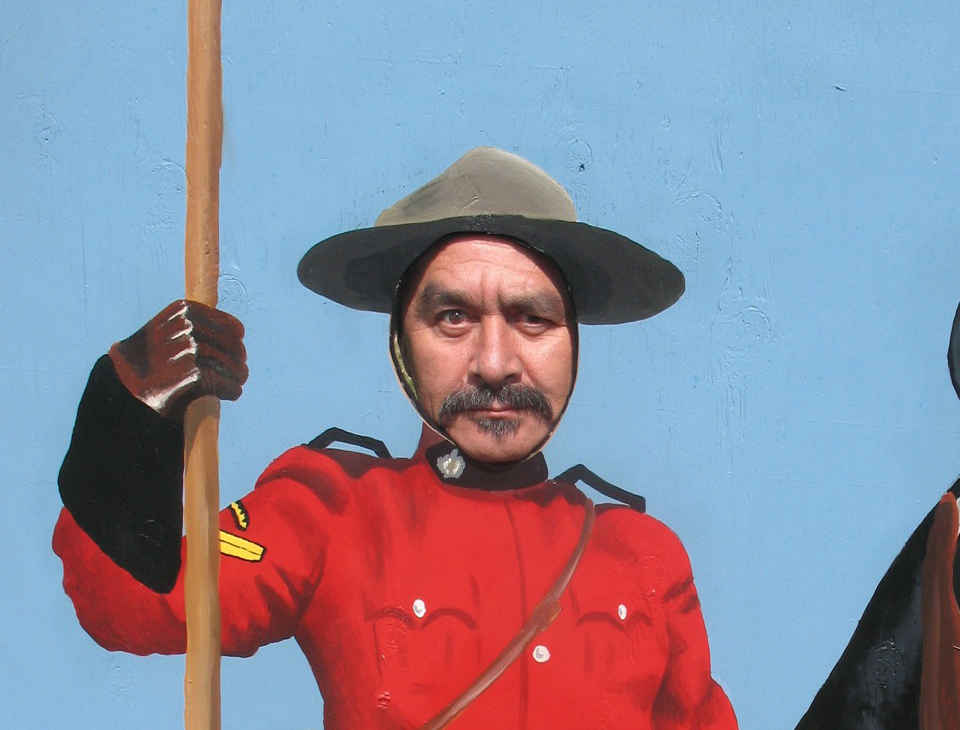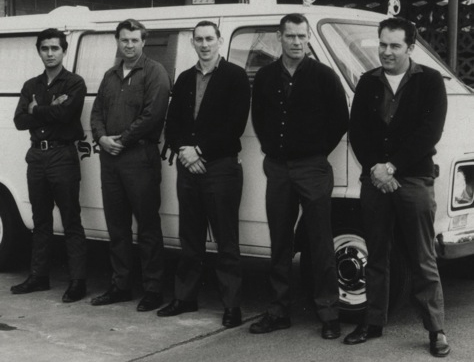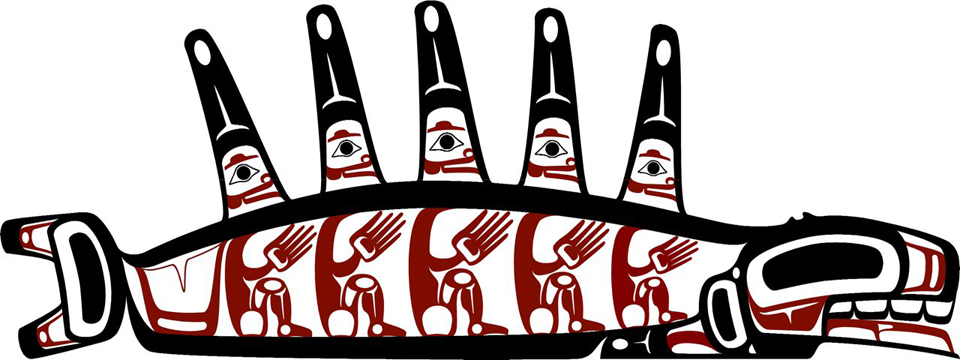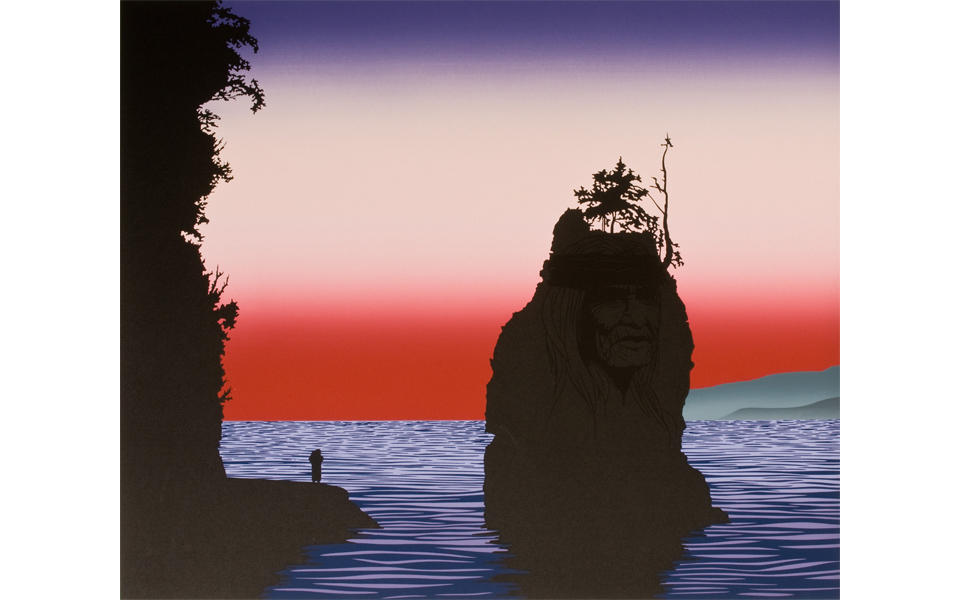Roy Henry Vickers, artist-teacher-healer-visionary-leader
Hear the latest podcast with this Kickass CanadianRecorded: March 4, 2014
“There are so many confirmations that I’m walking on the path that I should be walking on; that I’m in the right place, doing good things that make a difference to people in the world.”

“I will not draw in math class, I will not draw in English class, I will not draw in science class…”
Those were the words seven-year-old Roy Henry Vickers wrote on the blackboard on the many occasions his Grade 2 teacher caught him drawing outside of art class. Decades later, when she visited Roy at his Eagle Aerie Gallery in Tofino, British Columbia, his teacher proudly congratulated him on his accomplishments and admitted she wished she’d kept all his drawings.

‘Caribou Cowboys’
That would have been wise. Today, Roy is one of Canada’s most celebrated artists. His prints, paintings and carvings can be found in private and public collections and galleries around the world, including the Canadian Museum of Civilization in Ottawa, Ontario, the University of British Columbia’s Museum of Anthropology in Vancouver, B.C., the McMichael Canadian Art Collection in Kleinburg, Ontario and the National Museum of Ethnology in Osaka, Japan. The 10-metre Salmon Totem he carved for the 1994 Commonwealth Games’ aquatic centre still stands tall and proud near Victoria, B.C. His works have frequently been given as official gifts to the likes of Queen Elizabeth II, former Soviet leader Boris Yeltsin and former American president Bill Clinton.

‘A Meeting of Chiefs,’ gifted as an original to Queen Elizabeth II and as a limited edition print to participating countries at the 1987 Commonwealth Summit in Vancouver, B.C.
The list goes on.
Roy has become more than an artist; he’s part of Canadian history. In 1994, Maclean’s magazine included him as the first artist in its Annual Honour Roll of Extraordinary Canadian Achievers. In 1998, he was appointed to the prestigious Order of British Columbia. In 2003, he received the Queen Elizabeth II Golden Jubilee Medal. In 2006, he was made a Member of the Order of Canada for his work as an artist and as a “bridge between cultures for First Nations people.”

Receiving the Order of Canada from former Governer General Michaëlle Jean
Kickass Canadian Norm Hann recommended Roy for this website. The two stellar Canucks met years ago when Norm served as his guide on a fishing boat at King Pacific Lodge. Their shared connection to nature and a mutual desire to lead and teach made them fast friends.
“Not only is Roy an amazingly talented and highly decorated First Nations artist in a number of mediums, he is, most importantly, a passionate, respected leader who is incredibly supportive and giving to everyone around him,” says Norm, whose Standup4Greatbear crest was designed by Roy. “He’s an inspiration and role model to generations of people, and has a deep spiritual connection to his culture and traditions.”

‘Standup4Greatbear’ crest
Art in his blood
Roy’s culture and traditions are rich and diverse. His father was a fisherman, with the blood of three northwest coast First Nations flowing in his veins: Tsimshian, Haida and Heiltsuk. His mother was a schoolteacher of British descent. Throughout his career, Roy has drawn from the wide assortment of colours on his cultural palette, mixing them together to create powerful works of art that have touched millions.

Roy (left) and his great-grandfather Amos Collinson from the Haida
“Art is a wonderful way of expressing some of the mysteries of life so that others can see my point of view,” he says. “As a child, I wasn’t really conscious that I was drawn to art. It was just something that I was always did, from my earliest recollection.”
In Roy’s early years, art took the form of drawing. Today that passion extends to almost every medium available; he prints, carves, paints, writes, sings and plays guitar. He credits his creative bent to the people who surrounded him as a child. “I grew up in a musical village,” says Roy, who was born in Greenville, B.C. on the Nass River and spent his formative years on the First Nations reserve in Kitkatla. “The northern villages are famous for their musicians. It just runs in the blood somehow.” He describes the musical process as somehow innate to the people who inhabit the area. “I grew up with musicians all around me—people who couldn’t read music but who could play violin, saxophone, organ, any musical instrument. Show them how to play it and they’d play it.”

Almost a Mountie
When Roy was nine, his family, which eventually expanded to include three younger brothers and two younger sisters, moved to Hazelton, B.C. on the Skeena River, the place Roy calls home today. He attended Oak Bay High School, where he stood out as an artist from the first day of classes. Still, when he graduated in 1966, his first instinct was to join the Royal Canadian Mounted Police (RCMP). His love of horses, combined with a number of mentors in the RCMP, inspired him to decided at a young age that he was “going to get paid to rides horses all over the world.”

Roy reimagined as a Mountie
When he failed the medical exam due to being colour blind, a condition he’d later overcome in his art, he turned to the advice of another mentor: his high school art teacher Bill West. “Bill encouraged me not to study art if I went to university,” says Roy. “He recognized that I’d already proven my love of and devotion to art, and that I’d be better served by developing my uniqueness as an artist on my own than by (potentially) being pigeon-holed by an institution.”
So Roy enrolled in the University of Victoria’s anthropology program, again inspired by mentors in his life. But he didn’t even get to the end of first-term exams before having a change of heart. During one of his classes that term, “the professor was talking about the natives of the northwest coast and she mentioned that we were all of patrilineal descent,” says Roy, whose ancestors are all of matrilineal descent. “I decided that I didn’t want to study there; I obviously knew some things that the professor didn’t know.”
Living artfully
Roy stayed in Victoria, but not as a student. He took a job in the Fire Department, where he worked for seven years. He was devoted to his work, but always kept up his art on the side. His talent was abundantly obvious to everyone in his squad, and they continually encouraged him to quit his job and pursue art as a career. He resisted at first, both out of appreciation for his work and a worry that “artists die young, they die broke.” But a growing number of people in Roy’s life kept at him to make a go of art and, in particular, to study the traditional art of his ancestors.

Roy (far left) with his City of Victoria Fire Department squad
Lured by a strong pull to his roots, in 1972 he took a leave of absence from the fire department and enrolled in a two-year traditional First Nations art and design program at the Gitanmaax School of Northwest Coast Indian Art in Hazelton. It was love at first lesson. “I worked six days a week, 10, 12 hours a day,” he says. “I was given a key to the art school so I could go back there and carve at night. Most days, I’d get home by 10pm.”
After his first year at Gitanmaax, Roy went vacationing and found himself in Mexico. It was there that his eyes were opened to the possibilities of what he could accomplish if he devoted himself entirely to his art. “In Mexico, there’s no unemployment insurance, there’s no welfare,” he says. “If you don’t work, you don’t eat, you don’t make money. But people (in Mexico) were happy, and they just worked hard and they did whatever they could to make money. So on my way back to the art school, I thought, ‘If I left the fire department and went into my last year of art school with no job to come back to, I would work even harder. My whole attitude towards my creativity would have to change; it wouldn’t be a hobby, it would be my way of life.’”

At home with his ‘Eagle Totem’
Roy decided to make art his profession. He gave up his position at the fire department and focused his energies on building a career as an artist. In the end, the decision turned out to be a great one. After graduating from Gitanmaax, “I made more in that first year (as an artist) than I did in any year at the fire department,” he says. “I realized ‘I can do this,’ and I’ve been doing it ever since.”

‘A Chief’s Dream’
A bridge between cultures
Roy got around being a colour-blind artist because he created only traditional First Nations art using mostly black, white and red—colours he could distinguish. But in the early 1980s, he decided he didn’t just want to produce traditionally northwest coast art. “I’m your typical Canadian,” he says. “I’m Tsimshian, Haida and Heiltsuk, and I’m half English, and on the English side there’s Irish and Scottish. I’m made up of all of these different nationalities.”

‘Five Finned Whale’
Because of his colourful pedigree, he felt driven to tackle the world of colour in his paintings so that he could better represent the varied backgrounds of the First Nations people in northern B.C. He began a series of four paintings, one for each season. But for autumn, winter and spring, he chose muted greys for heavy rain and falling snow, and black and red traditional design for a canoe. He was still avoiding bright colours, and that wasn’t something that sat well with him.
“When I completed the first three paintings, I realized I had to tackle summer,” he says. “But I didn’t know how I was going to paint a sunset.” Roy drew on his creative spirit and found a solution. He used the form lines of traditional design and separated the colours in a sunset with bands of grey that were “like wisps of clouds.” Then he filled them in with colours he could distinguish on the palette. The end result was his first painted sunset, Westcoast Sunset.

‘Westcoast Sunset’
In creating the four-painting series, Roy did more than conquer his fear of working with colour. Just as he had hoped, he helped open the world’s eyes to the culture that exists in abundance in his traditional territory. “People who had no idea what northwest coast Indian art was were made aware of it and attracted to it, and then began to study it,” he says.
His incredible contribution set the stage for his ongoing role as a bridge between cultures, and led to his receiving the Order of British Columbia in 1998 and the Order of Canada in 2006. Over the years, he’s leveraged his clout and recognition to bring awareness to First Nations cultures and help redefine the way others view them. In his words, “What we need to do is stop thinking of ourselves as survivors and become people who are positive contributors to society.”

‘Siwash Rock,’ one of Roy’s best known works
Making a different set of rules
Along the way, Roy had to overcome demons of his own. In 1992, his career was going well. He had a long list of impressive customers and had opened his own Eagle Aerie Gallery in 1986. Located in Tofino, B.C., the gallery quickly became one of the area’s main attractions, drawing in hundreds of thousands of visitors every year.

Eagle Aerie Gallery
But the gallery and his sales didn’t paint the whole picture. “My life was not a work of art,” he says. “My life was a shambles.”
He had three divorces under his belt and was “co-creator of three dysfunctional family systems.” Things looked so bleak and colourless to him that he came close to taking his life. “I didn’t think I was any kind of a role model for anybody to follow and I didn’t know of a way out,” he says. “I thought that if there were a way out, I would take it. But I couldn’t see one.”
Thankfully, perhaps fatefully, it was at that time that his sister Patricia returned from Arizona’s The Meadows, a centre for recovery from addiction of all kinds—food, drugs, compulsions, obsessions, etc. “Patricia came back and she said to me, ‘Our whole family has addictive personalities and there’s a way out,’” he says.
His sister’s message, delivered in the same words Roy had been running through his mind, sounded loud and clear. Nine days later, he walked through the gates of The Meadows. “They gave me the tools to change my way of thinking and make myself a different set of rules,” he says.

‘Getting My Spirit Back’
Roy needed to face what he calls “all addiction. If I quit alcohol, then I’d become a workaholic. If I wanted to sober up, I’d go to church so I had a religious addiction. I grew up with this whole process. My greatest addiction was looking for love. I was addicted to any place that I could find love. No one taught me that the real place to find love… is with someone who begins their relationship with you as a friend.”
When he was able to, in the words of Bob Dylan, “change my way of thinking, make myself a different set of rules,” Roy suddenly saw the world through new eyes. “I’ve spoken many times about addiction and how there’s a way out of addiction,” he says. “You have to change the way you think until it’s a wonderful purview.”
Arriving at a place of peace
Roy’s different set of rules led him to a place a love with his current wife and best friend Andrea, whom he married in 2001. Together, they share a wonderful, loving marriage and two children, 10-year-old son Wakas and eight-year-old daughter Grace, who was named after Roy’s mother and who he calls “the next artist.”

From left: Grace, Roy, Andrea and Wakas, 2004
The Meadows brought about other changes in Roy’s life. After completing the program and returning to Tofino, he “had all of the knowledge that (The Meadows) gave me, plus I had this desire to continue to walk in this way of sobriety.” As he continued down that path, he found himself looking for spiritual guidance and knew that the answer would come in finding a traditional medicine man to help him fast and pray in the ways of his ancestors.
As with Patricia, the medicine man arrived to answer Roy’s question just as he was asking it. Through a friend in the RCMP, he was put in touch with a medicine man in the force and, within a week of realizing what he wanted, found himself embarking on his first fast, learning about sweat lodges and becoming a pipe carrier.
“A pipe carrier walks in the ways of the four directions, which are common to all nations in the world: teacher, healer, visionary and leader,” says Roy. “We always have the pipe in our minds so that when we get into situations where we feel like we’re off kilter or off centre or, we can always go back to this place of peace and centre ourselves, ask the creator to help us be who we are.”

‘Eagle’s Moon’
Those who can teach, should
The four directions of the pipe carrier are what bonded Roy and Norm when they first got to talking one-on-one on the waters of the Pacific. As Norm guided the artist, Roy introduced him to the idea of the teacher, the healer, the visionary and the leader with the following message:
“Before you can become a leader, you have to have your eyes and ears and heart open to all the lessons available to you everyday. You have to look at your life and realize that parts of you have run away, and you need to bring them back to recover those parts of yourself that are hiding because you cannot be a good leader in the whole world unless you are totally in touch with all parts of yourself. And you have to have good vision because it’s not with our physical eyes that we see, but with the eyes God gave us. We have to be able to look at ourselves and see how we’re travelling through this world and guide ourselves through this world prayerfully. When you can do that, then you become a leader, then you can see things that you need to do in this world as a leader. We’re all leaders and we all make a difference in the world.”

Roy, left, with fellow Kickass Canadian Norm Hann
Those words brought the two teachers together for life. They’re also “part and parcel” of what Roy is now teaching through the York Region District School Board.
In 2007, York University awarded him an honorary doctorate for his work as an artist and as an ongoing bridge between cultures. He was the keynote speaker for that year’s graduating class and part of his talk focused on the four directions. The Dean of Arts was fascinated by what he had to say on the matter. He put Roy in touch with one of his staff, and together they’re developing a program through which Roy will be a virtual teacher to secondary schools in the York region.

Receiving his honourary PhD at York University
The program launched this spring with an art class at Elder’s Mills Public School. Through iChat, Roy participated in online, interactive discussions with the students. It went so well that he and the school board are in talks to apply the program on a larger scale across a host of secondary schools in the region.

Storytelling with youth at the Eagle Aerie Gallery
Painting a beautiful picture
Roy often reflects on what his own art teacher Bill told him many years ago at Oak Bay High School: that everyone is unique. He said to Roy, “When you get to that place where you can express your uniqueness, you may hear people say, ‘I was looking at a sunset the other day and I saw one of your skies,’ or ‘I was out fishing the other day and I saw your water.’ When that happens, you’ll know that the power of your creativity is so ingrained in the people who are looking at your work that you effect a change in the way they see the world. They think of you when they see something that you have created.”

‘Great Escape’
Roy stops for a minute before continuing, his voice catching audibly. “I’ve heard that (from fans) thousands of times and each time it brings me to this humbling place. It brings tears to my eyes.”

Leading youth in song at Eagle Aerie Gallery
Now that he’s preparing to teach high school art to students of his own, he feels he is exactly where he’s meant to be: in a position to instill in them some of the wisdom his teacher Bill imparted. “There are so many confirmations that I’m walking on the path that I should be walking on,” says Roy. “That I’m in the right place, doing good things that make a difference to people in the world.”
I will draw in any class…
* * *
For the latest on Roy, visit royhenryvickers.com, email [email protected], follow @RHVickers on Twitter or join his Facebook group. You can also check out this video to see more of his work.
 Kickass Canadians
Kickass Canadians
I love his work and the Gallery is amazing, thank you for posting this interview.
Congratulations Roy, it was an honor to recommend you as a Kickass Canadian and to know you as a friend. I am glad our paths have crossed. Amanda, again, has done an incredible job capturing your story. “Sa am Tsa Heightken.”
It was an absolute pleasure to get to know Roy and write about his story. I’m honoured to have him in this space, as I am to have you both here, Jay and Norm. Norm, thanks so much for recommending Roy!! No wonder you two connected…
I would also like to thank Roy for his time, energy and contributions to The Ride to Live that raises funds for prostate cancer research, support and hopefully one day a cure.
Thanks John! Roy continues to show what a generous person he is, in very many ways…
This artist/man is very inspiring. Now I know if I turn my life around, my life will be awesome. My friend and I draw in class all of the time and now we have a great excuse! THANK YOU ROY!
Taylor, if you’re looking for inspiration, you’ve found a great focal point. Keep drawing 🙂
Thank you for allowing me to be part of this space. I continue to work at my expression and find those who communicate a passion for life, love and hard work.
Taylor, throughout my almost 40-year career, I’ve found that talent is not all that is necessary. I’ve met many who have far more talent than I, and yet they do not believe in themselves or get lost because of different distractions. Hard work and keeping to the truth, as well asking for inspiration from the source of all creativity, are the keys to being successful as a professional artist.
Love and Inspiration to all, RHV
Such amazing and impressive accomplishments.
Our first visit to Tofino and after spending five days surrounded by ocean, mountains and trees, we finally found an afternoon to see Roy’s gallery. Wow! He really captures the special nature of this place and its First Nations people. Very emotional and inspiring. I only wish I had the opportunity to meet this gifted artist.
Thank you for sharing, Jon! Sounds like a beautiful trip.